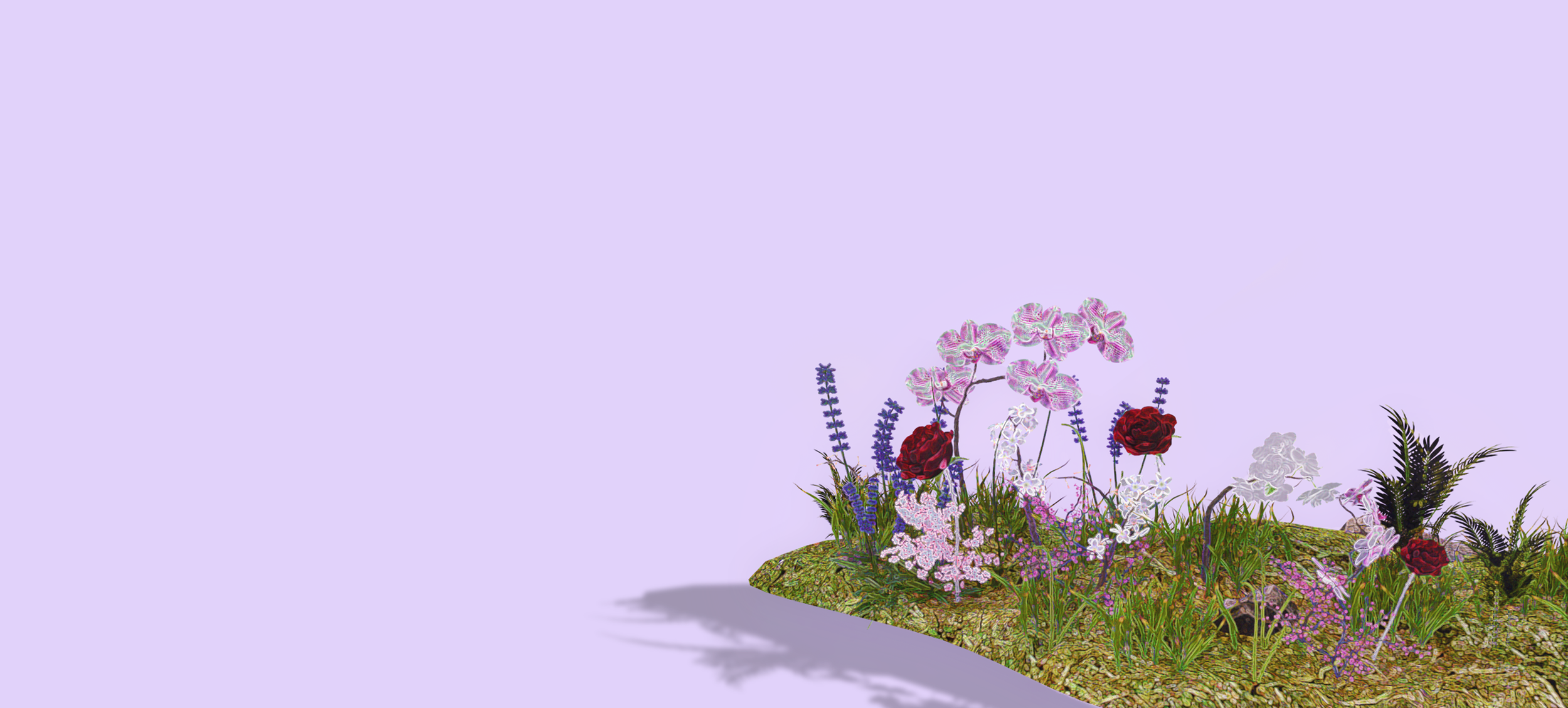
Blossom
Nov. 2023 - Feb. 2024
Timeline —
Role —
User Researcher MR Interaction Designer Mobile UI Designer
Individual Project
Collaborator —
Tools —
Figma Blender Adobe Set

Using aesthetic interactions that engage people with multiple senses, including visual, audio, and olfactory, students can immerse themselves in a serene virtual garden where they can grow and nurture beautiful virtual flowers. By engaging with nature in a virtual space, students can find a moment of peace and rejuvenation, improving their overall mental health and academic performance.
“Blossom Tranquility is an innovative Mixed Reality project designed to help college students manage stress and promote mental health.”

01. Problem Background
This collage represents my inspiration. As a college student, I am aware of the various factors that contribute to stress, including academic pressure, relationship challenges, career concerns, and financial worries. So I thought of a way to alleviate or solve the problem.
01. Context
Understanding that stress stems from more than just academics, I began to explore its broader impact on students like myself. This inspired me to dig deeper—what exactly are students going through, and how serious is the problem? To move forward meaningfully, I needed to ground my direction in research and real-world data.
02. Problem & User
In US, mental illness is becoming a serious problem
44% of college students have symptoms of depression.
Pandemic Impact: 2020 and 2022, the number of students that participated in counseling or therapy increased from 30% to 37%.
15% reported having considered suicide.
Focused driving force
Anxiety towards academic path, life, career.
The loss of a loved one / relationship problems.
Overstimulation and technology overload.
Why students refuse to seek professional help?
Receiving counseling is sign of weakness: takes courage to address problem areas and examine painful feelings.
Don’t know when should go to counseling (think the problem is not serious enough to go to see counselor).
Hard to schedule a time, waiting for too long.
Limited funding.
Campus space limitations: Most therapy rooms are located in the Student Wellness Center, but…
Limited availability: many campuses have a shortage of therapy rooms.
Lack of privacy: students may not want conversation therapy, preferring a more personal calming space.
Limited flexibility in scheduling: might only be available during standard office hours.

02. Research + Design Ideation
With a clearer understanding of the mental health challenges students face, I began exploring ways to intervene early, before their struggles escalate. I sought solutions online and from the people around me.
How to help?
Foster empowerment and self-control by helping individuals take charge of their lives, enabling them to make decisions, decorate, and arrange their surroundings with confidence.
Provide a safe space for rest and anonymous self-expression.
Provide an easy, low-cost, and quick solution to soothe emotions effectively.
Create an immersive, holistic experience.
01. Ideation
“How might we create an intermediate and easy way to help college students rest and process emotions before serious illness?”
Based on existing research and the key needs identified above, I narrowed down two core approaches to explore
Together, these two elements offer unique emotional and practical benefits that align closely with students’ needs.
Horticultural therapy+ MR: Use virtual plants garden as a way to help people take control of their lives.
Plants: Caring plants is one of the easiest & efficient way to gain control / Plants are accessible and easy to obtain.
Sense of purpose and accomplishment.
Reduce stress and improve mood.
MR technology has no environmental limitations / Immersive environments that provide safe, controlled setting.
02. Solution Benefits
Early Intervention: Students use these platforms to express concerns before they reach a crisis point.
Anonymity: The anonymity can encourage students to express their most honest feelings.
Personalized Experience: Students can customize the platform to create the experience they most comfortable with.
To better understand the root causes of student stress and validate my direction, I conducted firsthand research. I wanted to ensure the solution directly reflects real student experiences and needs.
I conducted an extensive survey of CMU’s college students to get their perspective and received 60 valuable responses.
57% report that their daily stress level is relatively high (4 out of 5).
97% says that the academic workload is one of the sources of their stress
03. Questionnaire + Interview
74% prefer a private and intimate space to relax and reduce anxiety.
65% believe that plants have a positive effect on their emotions.
66% believes that being around plants positively impacts their mood (4 out of 5).
I also interviewed a friend majoring in psychology, gaining valuable professional insights on stress reduction.
Multi-sensory synesthetic design: visual + sound + smell.
Add the process of control and cultivation.
Since studies show that sensory-rich environments can enhance emotional regulation and reduce stress, I began exploring how sound could deepen the experience.
04. Sound Design Idea
Natural Sound: Movement of different plants, raindrops falling on plantain, the wind in a pine
Low Frequency Sound: Stimulate the release of serotonin and other mood-enhancing chemicals in the brain
Binaural Beat Music: Different frequencies of sound delivered to each ear combine to form a single tone
Building on my earlier research into horticultural therapy, I examined which specific flowers could best support emotional well-being. Scientific studies and the symbolic meanings of flowers reveal that certain plants have the potential to reduce stress, evoke calm, and foster deeper connections, making them ideal elements for this sensory experience.
05. Therapeutic Flowers
To bring the concept to life, I mapped out a typical user journey, showing how a student might interact with the system on a stressful day. I demonstrated how each step supports emotional relief and recovery.
06. User Journey

03. Therapy Space Design
To bring my multisensory concept to life, the physical environment plays a crucial role. I therefore designed a dedicated therapy space that directly responds to the stressors and sensory needs uncovered in my research.
Here is a detailed explanation of how to integrate multisensory design into the space.
Demand-Controlled Ventilation: Sensor counts the number of people in the room and adjusts the ventilation.
Disposable Scent Pads: Essential oil and instructions will be provided to guide the student to place a few drops on the pads.
Sound Insulation Panel: Adding a soundproofing panel blocks ambient noise and allows for different therapy sounds.
Headset for MR: With a headset, students can use hand gestures to interact.
The therapy space can be situated in various locations such as student lounges, library discussion rooms, dormitories, classrooms, or wellness centers.
01. Detail Explanation
02. Exploded Diagram

04. APP + MR Design
To support the MR experience and enhance accessibility, I designed a companion app. Rather than being the central focus, the app serves as a supportive tool.
The app contains 4 main function:
Reserve the visiting time of the space
Check my garden
Graduation Gift
Professional Help
01. APP Design
As students engage with the therapy space and app, I want to give them a sense of personal growth and accomplishment, an idea supported by my earlier research on empowerment and emotional regulation. That’s why I designed an interactive garden that students can develop over time. It visually reflects their emotional progress and care.
This is the sketch of my envisioned garden that the students will develop.
02. Garden Sketches
To turn the envisioned garden into a actual customizable and immersive experience, I began developing the MR environment.
With MR technology, students can enjoy their personalized therapy garden anywhere they want. They have the freedom to customize the number, type, and density of flowers, as well as select various settings to create their ideal calming environment.
These images showcase the modeling process for flowers in Blender, which will be used for future MR applications.
03. MR Setting Modeling
I further developed the MR interface to support an interactive planting experience. Users begin by selecting a base environment, then customize the types and arrangements of plants and flowers they wish to grow.
04. MR Interface
I created a scenario showing how students will use the design and how it fits into their daily lives.
In this scenario, equipped with an MR headset, Sally immerses herself in a virtual gardening experience in her college library, where she can design and interact with a personal garden. As the virtual plants appear around her, Sally feels a sense of calm and satisfaction from creating her own natural space.
05. Scenario

05. Final Reflection
01. Takeaways + Possibilities
One key takeaway was the importance of providing users with agency and comfort, empowering them to shape their own healing experience. Every element, from flower selection to immersive space design, became a tool for emotional expression and grounding.
With more time and resources, I would develop a working prototype integrating the MR garden interface and test it with students in a controlled setting. This testing phase would be crucial to validate the interface's usability and sensory experience. It would also help uncover limitations, such as cases where users might not find the garden experience calming. These findings could inform design adjustments that better accommodate different emotional needs and relaxation styles.























